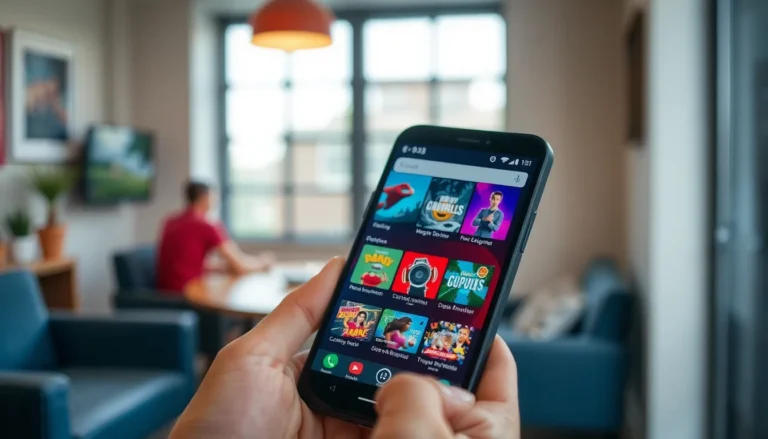Ever felt like your iPhone’s voicemails are playing a game of hide and seek? You’re not alone. Many users find themselves wondering why those important messages arrive later than a pizza on a Friday night. It’s frustrating when you’re left hanging, waiting for that crucial call back or the latest gossip from Aunt Edna.
Table of Contents
ToggleUnderstanding Voicemail Delays
Voicemail delays frustrate many iPhone users. Various factors contribute to delayed notifications and missed important messages.
Common Causes of Voicemail Delays
Multiple reasons lead to voicemail delays. First, device settings could affect notifications. If a user changes their network settings, it may slow down voicemail delivery. App glitches can also cause delays. Resetting the phone or updating the operating system often resolves these issues. Lastly, voicemail storage fills up over time. When the storage reaches its limit, it may block new messages.
Network Issues Affecting Voicemails
Several network issues can impact voicemail delivery. Poor cellular signal strength results in delayed notifications. If a user experiences weak coverage, voicemails may take longer to appear. Network congestion during peak times can also slow down delivery. With many users connected to the same network, delays become common. Switching to Wi-Fi calling in low-signal areas helps in maintaining connectivity and improving voicemail performance.
Troubleshooting Voicemail Delays
Voicemail delays can stem from several common issues. Users can follow specific troubleshooting steps to address these concerns effectively.
Checking Carrier Settings
Carrier settings play a crucial role in voicemail functionality. Users should navigate to the Settings app, then tap on General. From here, selecting About may prompt a carrier settings update. Keeping these settings up to date ensures optimal voicemail performance. It’s also essential to verify that the carrier provides voicemail services compatible with the iPhone model. Users should contact their carrier for any additional guidance to resolve ongoing voicemail challenges.
Restarting Your iPhone
Restarting the iPhone often resolves minor glitches affecting voicemail. Users can hold down the power button until the slider appears, then swipe to turn off the device. After a brief pause, turning it back on can refresh the system. This simple step clears out temporary files and may resolve any connectivity issues. Additionally, restarting helps in syncing with the carrier network more effectively, making timely voicemail notifications a reality. Regular device restarts can enhance overall performance and reduce voicemail delays.
Optimizing Your iPhone for Voicemails
Voicemail performance hinges on two main areas: software updates and device storage. Addressing these aspects can greatly improve the speed and reliability of voicemail notifications.
Updates and Software Fixes
Regular updates enhance software stability. Users should frequently check for updates in the Settings app under General and Software Update. Each update may contain essential fixes that improve network connectivity and voicemail functionality. Moreover, applying these updates can eliminate minor glitches affecting voicemail delivery. Keeping the iPhone’s operating system current prevents delays often caused by outdated software. Following these steps ensures uninterrupted access to timely voicemail alerts.
Managing Storage Space
Sufficient storage space plays a critical role in voicemail performance. Clearing unnecessary files and apps can free up space for voicemail functionality. To check storage, navigate to Settings, then General, followed by iPhone Storage. When storage approaches capacity, performance issues like delayed voicemails become common. Removing unused applications and media files aids in smooth operation, promoting quicker message notifications. Regularly managing storage prevents delays and enhances overall call and voicemail reliability.
When to Contact Your Carrier
When voicemail delays persist despite troubleshooting efforts, contacting the carrier becomes essential. Experts suggest several scenarios when reaching out is necessary.
Signaling Issues
Signaling problems can prevent voicemails from arriving promptly. Poor cellular signal strength hampers the ability to receive messages. If a user frequently experiences dropped calls or poor service, it’s vital to inform the carrier. The carrier might suggest checking coverage maps or areas with known outages. When multiple users in a region report similar issues, alerting the carrier helps address network concerns effectively.
Account Settings Check
Incorrect account settings can also lead to delayed voicemails. It’s beneficial for users to verify that their plan supports visual voicemail and that all associated features are enabled. Users should confirm voicemail passwords are set correctly. Sometimes, simple misconfigurations in the account can cause disruptions in service. If discrepancies arise, the carrier can help rectify the situation, ensuring smoother voicemail delivery.
Voicemail delays can be a significant annoyance for iPhone users. By understanding the various factors at play and implementing the suggested troubleshooting steps, users can often resolve these issues. Regularly checking settings and ensuring the device is updated can make a noticeable difference.
If delays continue despite these efforts, reaching out to the carrier is a smart move. They can provide insights into potential network problems or account settings that may be affecting voicemail delivery. With the right approach, users can enjoy a more efficient voicemail experience, ensuring they never miss an important message again.




